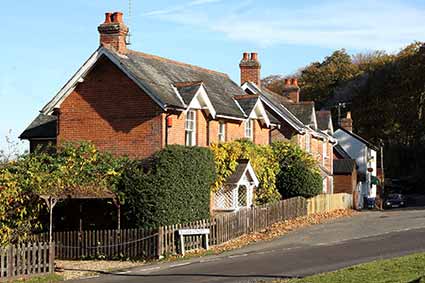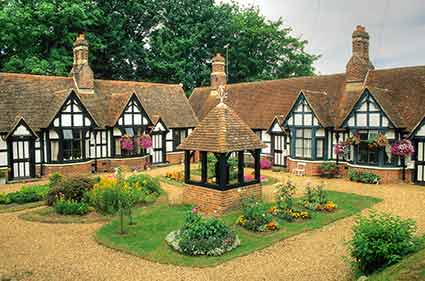Emery Down - an introduction

A small hamlet clustered around a hilltop overlooking Swan Green and Lyndhurst, Emery Down in 1379 was known as Emerichdon, and in 1490 as Emeresdowne - the name probably referred to land belonging to the Emery family.
Christ Church, the parish church, is of 19th century date. Designed by William Butterfield, and built of polychrome Cornish brick and Bath stone, it was consecrated in 1864.
Construction costs were met by Admiral Frederick Moore Boultbee, a significant Emery Down benefactor, who in 1856 settled in the village with his niece Charlotte. Charlotte kept house for him in a thatched cottage known simply as The Cottage, which had been purchased from a Colonel Hogg for 1,500 pounds.
Born in 1798, the Admiral had a long naval career. He entered the service in 1811 - at the age of 13 - as a First Class Volunteer on board the 74 gun Conquestador. Between 1814 and 1820 he served as Midshipman and Master's Mate in the Favorite, and was promoted in 1821 to Lieutenant. In 1825, during action in suppression of the slave trade, he distinguished himself as a Spanish brig was captured. Promoted to Commander in 1829, he became Captain in 1841 and although not by then actively employed, promotion to Rear-Admiral on the Reserved List followed in 1862. He became Vice-Admiral in 1867, and Admiral in 1875.
The Admiral died in 1876, and after Charlotte's death 20 years later, their house was bequeathed to the church. The thatched roof was replaced with tiles, and the pretty, old cottage was transformed into a red-brick Vicarage.
This, however, was in sharp contrast to its earlier history for until the late 18th century it had been the village inn, The Running Horse. By 1801, though, it was the home of the Reverend Edward Poole. Situated a short distance away, and on the opposite side of the road, from the New Forest Inn, it is now again in private hands, and is most appropriately known as The Old Vicarage.
The village school, too, owed its existence to the Admiral. Opened in 1865, it replaced what was described as ‘a primitive dame school kept by old Mrs. Davis’. Extension or rebuilding in 1885 is commemorated by an ornate plaque on a side wall.
The school continued to provide education for local children until 1950, when the pupils transferred to Lyndhurst. The school bell, though, is displayed in the church – it is on the wall directly opposite the entrance door. After a period of use by the New Forest Verderers, the building is now a private residence.
Opposite the school, the five alms houses, also designed by William Butterfield, were built in 1871 for the benefit of elderly people of the parish. Admiral Boultbee was again the benefactor, and to this day the houses are known as Boultbee Cottage.
The Admiral’s generosity was, however, helped by a Lyndhurst resident, Sir James Schoedde, a retired army general who lived at Elcombs, the imposing building opposite Queen’s House. Mrs. R. Bowden-Smith, in a document lodged with the Christopher Tower Library, Lyndhurst, recalls Sir James’ death in 1861 from ‘a cold caught going to Early Communion Service’, and notes that: ‘He left a sum of money to Admiral Boultbee to spend in charitable purposes..…..Admiral Boultbee built the little church at Emery Down with the money…..’
Separate tablets inside the church commemorate both the Admiral and his niece Charlotte.
In the late 19th century, the celebrated novelist Mary Elizabeth Braddon and her husband John Maxwell, who lived at nearby Bank, provided for Emery Down a public Reading Room. This was later used as a school annex, and after a further period of use as a Forestry Commission store, was eventually demolished.

The village hall in Mill Lane was constructed in the 1920s at the instigation of the Misses Chamberlain, cousins of Prime Minister, Neville Chamberlain. The ladies lived at Bank, and owned property in both Bank and Emery Down. The hall continues to offer a focus for village life and is available for hire for wedding receptions and other events.
The New Forest Inn, formerly the New Inn, dates back to at least the first half of the 19th century. Tradition has it that the site was originally occupied by a caravan around which the current building evolved – the weather-boarded central section at the front lends some credence to this theory. In the early years of the 20th century, the right-hand part of the present building was separately operated, and offered teas and furnished apartments.
Find out more about Emery Down
References:
Lyndhurst Historical Society publications – The Story of Bank: Roy Jackman
Transcript of a talk given by Mary Britten to Lyndhurst Historical Society in 1984
Lyndhurst – A Brief History and Guide: Georgina Babey and Peter Roberts
More links
Other related links
Search this site

Sadly, 58 animals were killed - 35 ponies, 13 cows, 8 donkeys and 2 sheep, whilst a further 32 were injured - 3 pigs, 9 donkeys, 11 cows and 9 ponies.
(Forty-three accidents occurred in daylight, 15 at twilight and 101 in the dark. Twenty-seven accidents were not reported by the driver involved).
Here's just one horrific example - Three donkeys killed in collision with van at notorious New Forest blackspot (Advertiser and Times)

